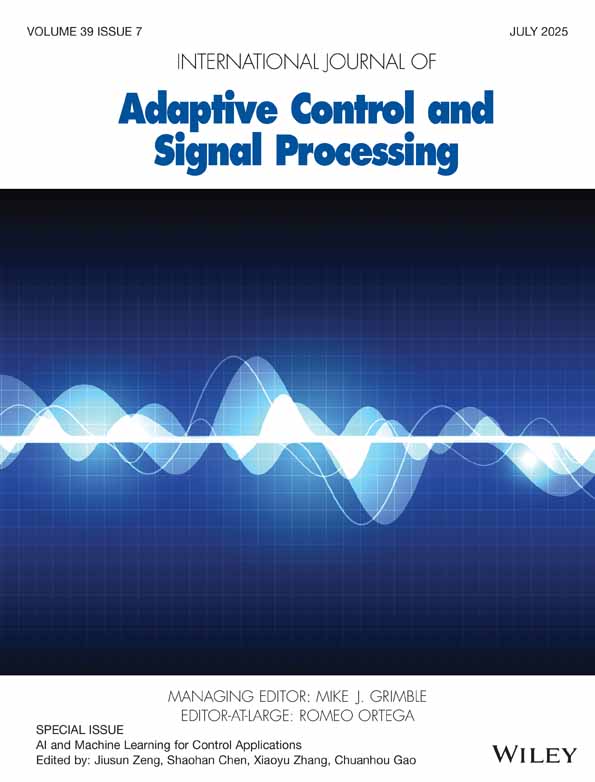Editorial
Abstract
This special issue contains the revised and updated versions of the papers presented in the session on adaptive identification and control held at the 45th IEEE Control and Decision Conference in San Diego, CA, on December 12–15, 2006, co-organized and co-chaired by Joseph Bentsman and Miroslav Krstic. Covering stochastic modeling and identification, adaptive identification and control, and automated fault detection for distributed parameter systems governed by partial differential and functional equations, the papers provide a coherent selection of novel results in the area.
This is the second special issue on adaptive identification and control of distributed parameter systems (DPS) in the International Journal of Adaptive Control and Signal Processing. The first issue 1 published 8 years ago under the same invited editorship has served well as a reference in the area. The motivation for the second issue is a continuing fascination with this research area, a growing applications pool, and an enormous leap in the computational capabilities, on one hand, and the significant progress that has taken place in this area, on the other. The issue follows a very well-received session on adaptive identification and control organized by one of the invited editors and Miroslav Krstic at the 45th IEEE Control and Decision Conference in San Diego (2006). Starting with a paper on stochastic mathematical technique 2 with application to parameter estimation, continuing with two papers on adaptive identification 3, 4 and a paper on disturbance rejection in adaptive control 5, and concluding with a paper simultaneously addressing adaptive identification and control, as well as automated fault detection 6, the issue provides a well-rounded representation of novel results in the area.
The issue starts with paper 2 by Duncan et al. that presents an analytical technique for modeling of a spatiotemporal noise in DPS in terms of a cylindrical fractional Brownian motion—a family of Gaussian processes with continuous sample paths. Paving the way for further progress in adaptive control of DPS, the paper provides solutions as well as the sample path properties of these solutions for a class of linear and semilinear distributed parameter equations. For the linear equations, the mild solutions are obtained, with the characterization of the limiting Gaussian measures provided. For the semilinear equations, the solutions provided are either mild or weak. The weak solutions are obtained by transforming the measure of the associated linear equation by a Radon–Nikodym derivative (likelihood function). An application to identification is given by obtaining a strongly consistent family of estimators for an unknown parameter in a linear equation with distributed or boundary noises.
Paper 3 by Smyshlyaev et al. addresses adaptive identification of parabolic partial differential equations (PDEs). This work goes beyond the existing identification framework by considering boundary actuation for the unstable plants, resulting in the closed-loop identification, and also introducing boundary sensing. Two benchmark plants are considered. The first one is with an uncertain parameter in the domain and the other one is with an uncertain parameter on the boundary. The adaptive identifiers, which consist of standard gradient/least-squares estimators and backstepping adaptive controllers, are synthesized. The parameter estimates are shown to converge to the true parameters when the closed-loop system is excited by an additional constant input at the boundary. The results are supported by simulations.
Paper 4 by Orlov et al. provides a tutorial overview of identification issues for linear time-delay systems (LTDS′) with finitely many lumped delays. A general framework for the output feedback identification of single-input–single-output LTDS′ with unknown multi-delays in the state vector and the control input is additionally presented. In order to demonstrate how the approach can be practically applied, the adaptive identifier, which consists of a sliding mode state observer and a parameter estimator, is tested in an experimental study of identifying the transient fuel parameters in a Port-Fuel Injected gasoline internal combustion engine.
In paper 5 by Kim and Bentsman, a recently introduced class of the well-posed error systems and the corresponding robust model reference adaptive control (MRAC) laws for the systems represented by the parabolic or the hyperbolic PDEs with the spatially varying parameters and a distributed sensing and actuation is extended to encompass the disturbance rejection capability. Several common disturbance models are considered. The case of the time-invariant disturbance model is shown to lead to a distributed adaptive PI control law, thereby making a well-posed connection to the classical finite-dimensional control structures. The numerical simulations indicate that the control laws proposed are robust with respect to the plant/reference model as well as the disturbance/disturbance observer mismatch in the boundary conditions.
In the last paper of the issue 6 by Demetriou et al., the MRAC, adaptive parameter identification, and automated fault detection are developed side by side for a class of positive real infinite-dimensional systems. Uncertainties in the plant description are viewed as additive perturbations, and a unified framework is developed to treat the aforementioned issues. A special attention is paid to the well-posedness and stability of the proposed adaptive schemes. Extensions to the variable structure observer, to specific forms of the structured perturbation terms, and to slowly time-varying systems are then considered within the developed framework.
We thank the Managing Editor Professor Mike Grimble for invitation to put this issue together, and Erin Murrin, Alex Owen, Adele Davies, and Jennifer Hillier for their timely help with the logistics of paper handling.




